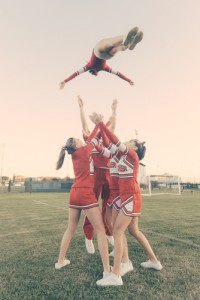The Serious Risks Of Cheerleading
 Overall, cheerleading is safer than contact sports such as football, but stunts and tumbling still come at a high risk. According to The New York Times, cheerleaders make up 66 percent of catastrophically injured female athletes, ones who are hurt so badly they are disabled or suffer medical problems for the rest of their life.
Overall, cheerleading is safer than contact sports such as football, but stunts and tumbling still come at a high risk. According to The New York Times, cheerleaders make up 66 percent of catastrophically injured female athletes, ones who are hurt so badly they are disabled or suffer medical problems for the rest of their life.
This comes as a surprise to many who picture cheerleading as nothing more than jumping, waving pompoms and getting the crowd excited. But it’s true – in 2007, nearly 27,000 cheerleaders found themselves in the hospital with injuries from participating in their favorite sport.
Find out what types of injuries cheerleaders are at risk of sustaining and how to prevent those injuries by seeking services from Spinal Healthcare.
Most Common Risks of Cheerleading
Cheerleaders are most likely to become injured if they have poor techniques combined with deficient strength, flexibility and balance. The most common risks include:
- Stress fractures: Repetitive tumbling routines strain the spine and can result in stress fractures.
- Growth plate injuries: Wrists, elbows, ankles and knees have growth plates, which can be traumatized by the repeated strain of stunt activities.
- ACL tears: Landing short or in an off-balanced position can stress knee and ankle ligaments, causing them to fail. The anterior cruciate ligament (ACL) in the knee is at particular risk.
- Concussions: The New York Times cites a study that states concussions comprise 6 percent of all cheerleading injuries, nearly all of which occur while performing stunts. Surprisingly, the spotter or person catching the “flier” is more at risk for injury than the flier herself.
Preventing Cheerleading Injuries
It’s impossible to fully prevent minor or catastrophic injuries when you participate in competitive cheerleading, but you can take steps to decrease the risks:
- Warm up and cool down: Stretch all major muscle groups, including your back, before every practice or performance. Hold all stretches for 30 seconds and repeat two to three times as needed. Repeat after each practice or performance to cool your muscles down and increase flexibility.
- Perform core-strengthening exercises: Crunches, sit-ups, planks and other exercises work your abs and back muscles. A strong core decreases the likelihood of injuries.
- Train in proper landing techniques: Learn how to land in a balanced, athletic position with the shoulders over the knees and knees over the toes.
- Undergo balance training: Your training should include both stationary and dynamic activities, progressing incrementally until you can successfully balance on unstable surfaces with ease.
- Train in intervals: To prevent overuse injuries, don’t perform repetitive tumbling activities every day. On days when training occurs, follow intervals of tumbling with times of rest.
- Only train under a certified coach: You want a coach who has completed safety and certification programs to learn proper training techniques and how to recognize the difference between normal aches and significant injuries requiring time away from cheerleading.
Signs of Developing and Significant Injuries
Aside from concussions, most cheerleading injuries are from overuse. These develop gradually and may lead to long-term pain and function loss if not addressed quickly. Watch for these signs of overuse, and seek treatment if your symptoms persist for more than a few days:
- Pain with activity
- Intermittent joint pain and swelling that gradually becomes constant
- Muscle aches and soreness
- Decreased strength
- Smaller range of motion
Then, look for signs of significant injury. If you notice these, seek immediate medical attention:
- Obvious deformity
- Significant bruising, swelling or discoloration
- Tenderness over a bone
- Tingling and numbness
- Extremely hot or cold skin
- Inability to move or bear weight on a body part
At Spinal Healthcare, we offer Sports Medicine services to help prevent injuries, manage injuries and enhance your performance. We believe in prevention but also have the resources necessary to treat injuries so you can return to the sport you love as soon as possible.
To learn more about our Sports Medicine services and other rehabilitative treatments, please contact Spinal Healthcare & Physical Medicine or call us at (260) 493-6565.
Leave a reply →




